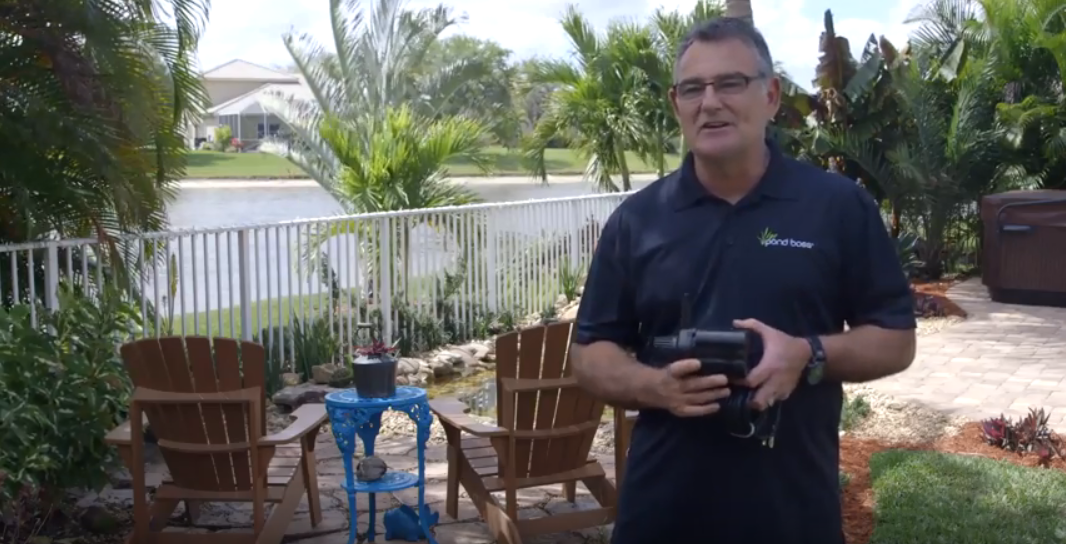
How to Pick the Right Pump
Now that is it spring, it is time to start new outdoor projects! For many people, this means adding a new water feature such as a pond, waterfall, or fountain. As you start one of these projects, the heart of your project will be your pump. pond boss is here to help make the selection of your pump simple. Follow the guides below to pick a pump based on the water feature you have selected.
Pond Pump
The pump in a pond’s primary purpose is to circulate water, as stagnant water is prone to algae and bacteria growth as well as attracting mosquitos. The circulation of water help keep water healthy and balanced. Pond pumps are also ideal for attaching a filtration system, pond nozzles, or small features such as a spitter. Selecting a pond pump is based on the size or your pond and the volume of water it will hold. First, calculate the volume of your pond by measuring the length, width, and depth. Next, use this formula to determine the volume of your pond:
For circular ponds:
DIA x DIA x DEPTH x 5.9 = gallons of pond water
For rectangular ponds:
LENGTH x WIDTH x DEPTH x 7.5 = gallons of pond water
This calculation is for a rectangular pond, so if you have a circular pond, the total gallons will be less than the calculation here. Finally, select a pond pump based on the volume of your pond. Pond pumps are rated by gallons per hour. You will want to select a pump as close to the total number of gallons per hour as your pond has to circulate the water in your pond once per hour. The slowest turnover we recommend is one time every two hours. For example, if your pond is 700 gallons, we would recommend a pump that is rated for 700-GPH (1 turnover per hour) to 350-GPH (1 turnover per 2 hours). Now, that you have your pond pump selected your pond will really begin to come to life.
Waterfall Pump
Waterfall pumps are selected either to power just a waterfall or both the waterfall and the pond it is attached to. You should determine the needs for your waterfall first and then determine if a secondary pump is needed for just circulating the pond water. First, measure the height of the waterfall (in feet) and the width of the water opening at the top of the waterfall (in inches). Waterfall pumps come with a flow chart, so you are able to see the water volume that the pump can push at various heights. Next, Find the height of your waterfall on the flowchart to check the GPH listed at that height.
The rule of thumb is for every 1 in. of weir width, you need 100 gallons per hour flow to achieve a “sheet” look.
For a “trickle” look, divide by two.
For a “Niagara” look, multiply by two.
Finally, if the water flow level at your waterfall height will be too strong, look at a smaller pump, or if it is too low of a flow, look at a larger pump’s flow chart until you find the best match. If you plan to put the pump far away from the waterfall, add that distance into your calculations.
Once your waterfall pump is chosen, the GPH at the waterfall height flow chart determines if the pump is appropriate to circulate the pond water as well or if an additional pond pump is needed. Check the information in the pond pump section to determine if the turnover rate is large enough for your pond volume. If not, determine the secondary pond pump needed from the pond pump section.
Fountain Pump
Fountain pumps are selected based off of pumping height. You will need to measure from the top of the water level that sits in the basin of the fountain up to the top of the fountain where the water comes out (in feet). Compare this measurement to the flow chart on the side of the fountain pump to make sure that it pumps that height as a part of the ideal pumping height as marked on the flow chart. Once you have found a pump that meets that criteria, you should check to make sure that the pump matches any tubing in your fountain or select tubing to match if you are building your own fountain. Once everything is selected to match the criteria of your pump, your fountain will be up in running in no time.
Finding the best pump for your water feature may seem overwhelming, but with these few tips selecting the best pump for your needs should now be much simpler.


